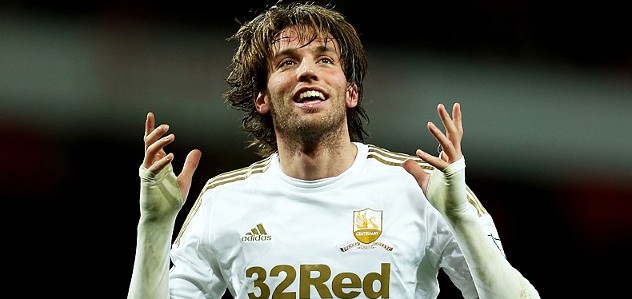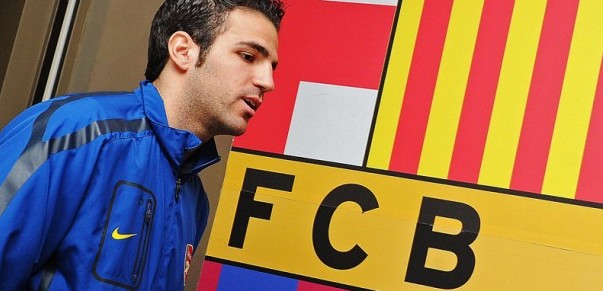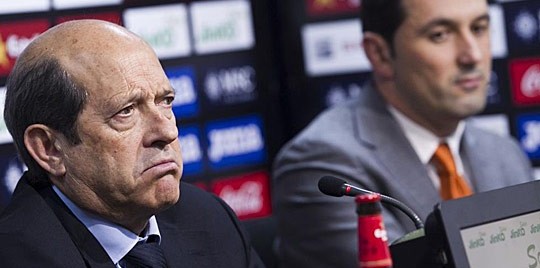- S.D. Eibar ready for maiden La Liga outing
- SD Eibar stengthen ahead of debut La Liga season
- Can ‘Super Mario’ live up to expectations in Madrid?
- MAN IN THE GROUND – Brentford 0 – 4 Osasuna
- Historic Basque derby welcomes S.D. Eibar to La Liga
- Munich to Madrid, via Brazil – Tony Kroos
- Rakitic in Spanish Switch
- Can Spain find redemption in Rio?
- Viva Espana! A season of redemption for Spanish football
- From the old to the new: who can fill the void in years to come for La Roja?
THE SPANISH FOOTBALLING REPUBLIC OF INGLATERRA (AND WALES…) PART THREE
- Updated: 9 September, 2011
SPANISH PLAYERS AND THE LOWER LEAGUES
By Alex Bromley
The world domination of the Spanish national side and Barcelona’s supremacy over club football has placed a high demand on the prefabricated midfield playmaker – everyone wants their very own Xavi Hernández and Andrés Iniesta.
However, while clubs such as Manchester City and Chelsea can dip into their piggy banks to bring players such as David Silva and Juan Mata to the Barclays Premier League, clubs in the lower echelons of English football face a sterner task in securing the services of the much-sought after Spanish player.
For every Xavi and Iniesta playing at the highest level in Spain, there are hundreds of talented players unable to break into the big-time in La Liga – this is the market that is drawing interest from Football League clubs.
The attraction of coming from Spain to play in League One or Two poses problems however.
Problems that help explain why there are so few of them plying their trade in these surroundings.
The first dilemma is a personal one for the player himself.
Do they leave the frustrating, yet familiar life as a squad player at a Primera or Segunda club, or move to a foreign country to play against such teams as Walsall and Stevenage Borough on a windswept Wednesday night in December? (No disrespect intended to these fine clubs.)
The answer would, at first seem obvious.
Yet the prospect of impressing a new audience and possibly earning a lucrative move to the Barclays Premier League, or indeed even the Championship is a prospect that many are beginning to view as , potentially a good career move.
The possibility of being a proverbial Latin version of Lee Trundle or Charlie Adam could become attractive; being a Spanish footballer in a lower English league is potentially akin to being a big fish in a small pond – which will win you a lot of fans, a lot of plaudits and make you feel good.
However, the short and sweet passing game that is currently flavour of the month, is only achievable in a side that has the overall quality to utilise it.
This style of football runs through every player at a club such as Barcelona like a life blood, from the youth sides right up to the all-conquering first team.
They also have the quality of player to make the system look effortless.
Arsenal play their own style of ‘beautiful’ football (if a little less successful), and Wigan Athletic and Swansea City have also shown that it can work in England.
However, there is a big divide between the skill and panache of the Premier League and the physical bludgeoning of League One and Two.
As such, nimble and twinkle-toed playmakers simply get shoved about by the opposition and fail to adapt to the more demanding style of football.
To find a Spanish player in the third or fourth tier of English football today is a rare occurence indeed and, as the stats show, those that have played at that level have rarely been effective.
In League One, Charlton Athletic, who signed Mikel Alonso in the summer have made a great start to the season and are so far unbeaten, playing some free-flowing football.
However, despite Mikel being the big brother to a World Cup Winner Xabi no less, he is yet to play a league game for them.
It is of course, early doors as the player only arrived a month or so ago, but he is as of yet, an unused luxury.
Likewise of Charlton’s other young Spaniard, Ruben Izquierdo who signed from Halesowen Town and has as yet only played one match having come on as a late substitute.
Aside from Exeter’s Guillem Bauza, who has taken to the division like an absolute storm (possibly due to his physical style), Spanish players are all but vacant from sides outside the top two divisions
Evidently Spaniards are the best in the world, but not necessarily in all types of football.
So what happens next?
Does a player stick it out and become tougher – as Mikel Arteta and Cesc Fabregas did for several seasons when the Premier League was more physical, or do they wait for the style of English lower league football to change and catch up?
Needless to say, they could be waiting a fairly long time for that prospect.
So for now, rather ironically, it appears that the English beefcakes and hard-lads are more suited to the football played in the lower leagues than their skilfully nifty Iberian counterparts.
On that understanding, don’t expect the next Latin midfield maestro to be gracing the hallowed turf of the Bescot Stadium any time soon.
Follow @icentrocampista







One Comment
You must be logged in to post a comment Login